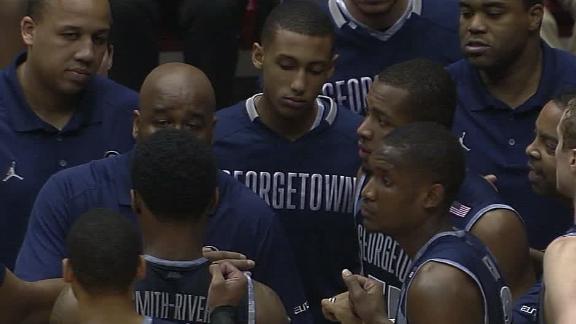Georgetown’s Big Three Replacing Otto Porter’s Offense Nicely
Posted by Alex Moscoso (@AlexPMoscoso) on December 19th, 2013Georgetown is on a six-game winning streak after defeating Elon at the Verizon Center on Tuesday night. Elon gave John Thompson III’s squad all it could handle after hitting eight three-pointers in the first half, but in the second half, the Hoyas’ “Big Three” of Joshua Smith, D’Vauntes Smith-Rivera, and Markel Starks led the team back from a possible upset by scoring 36 of their 46 second half points. In a previous post on the topic, I discussed how Thompson was using these three players in tandem to replace the loss of Otto Porter by committee. Now that a quarter of the season is complete, this strategy has become even more apparent. While Smith, Smith-Rivera and Starks provide the offensive punch, JTIII relies on his role players and bench to shore up the Hoyas’ rebounding and defense.
The Big Three accounts for 45.2 points of the team’s 75.5 PPG, or 60 percent of the overall scoring. When Porter left after last season, he took 16.2 PPG with him. This season, Smith has added 13.6 PPG, Smith-Rivera has improved his average by 7.7 PPG, and Starks has improved his by 2.2 PPG; the sum of these is an increase of 7.3 points more than Porter’s average. While the trio has more than replaced their former teammate’s points, they have fallen well short of replacing his rebounding and defense. Last season, Porter grabbed 7.5 RPG and had a defensive rating of 85 (which means he would allow 0.85 points per possession). This season’s rebounding contribution from the Big Three — accounting for the addition of Smith and the improvement in boards from the other two — is 3.6 RPG, which is nearly four rebounds per game short of what Porter was contributing. Additionally, all three players are lacking in defensive effectiveness — Smith is the closest to Porter with a defensive rating of 94.1. The gap in defensive rating may even understate the impact of Porter’s absence since he was used extensively against the opponent’s best player, which is not captured in the rating.
Thompson uses his long and athletic bench to provide a defensive presence and clean the glass. On the defensive end, the Hoyas have relied on Moses Ayegba, Mikael Hopkins, and Nate Lubick; and their respective 82.6, 90.0, and 87.9 defensive ratings. Hopkins has made the biggest leap by improving his rating by 5.6 (although he is playing fewer minutes per game from last season). These three have helped stem the tide and as result have kept the Hoyas defense ranked 32nd in the country in defensive efficiency. Not nearly as impressive as their ranking of second from last season but enough to keep them competitive with their much more potent offense (jumped from 78th to 49th in the nation in offensive efficiency). Finally, the committee of Aaron Bowen, Hopkins, and Lubick have improved their rebounding by 6.5 boards a game; Hopkins had the biggest improvement of 3.2 RPG.
The Hoyas’ new three-headed monster has significantly improved the Georgetown offense from last season and their role players and reserves have improved on defense and on the boards enough to keep this team successful in the post-Porter era. JTIII will need to have this symbiotic relationship continue to balance itself during the upgrade in competition during conference play if he wants a fourth league title, a completely possible if not probable result.













































